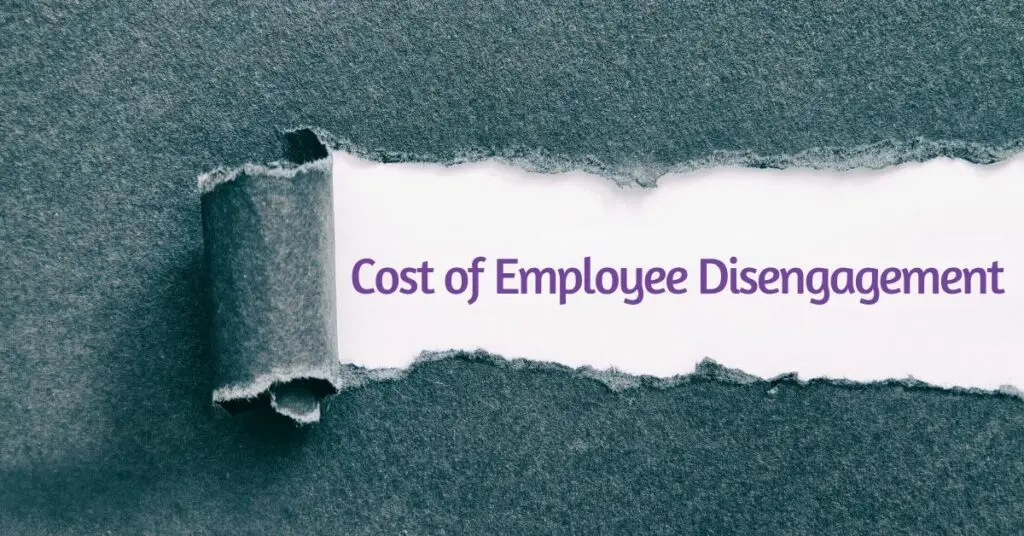The cost of employee disengagement on the productivity of any business is significant. While there continues to be a lot of buzz around disengaged employees, have you ever really thought about this issue and how it directly influences your productivity? I’m sure you have at one time or another.
Today, we will discuss the cost of employee disengagement and how you, as a leader, can change that. Before we dive into this content, let me share a quick story about a time when my lack of fulfillment directly influenced my productivity.
I worked for a large organization as a Marketing Assistant early in my career, and unfortunately, the role wasn’t a great fit. Over time, I found myself disconnecting from my work, and as I reflect, there is no doubt I was far less productive when I finally decided to leave and pursue something else.
The Research and Correlation Between the Cost of Productivity and Disengaged Employees
According to Indeed.com, Productivity is the work an individual or group accomplishes within a specific time. Greater productivity means you complete more with less time or effort. Research shows that productivity is negatively impacted when employees are stressed and frustrated. There are some obvious connections: reduced output and quality of work, increased absenteeism, and the immense cost associated with disengaged employees.
Today, I want to explore this topic through the lens of teamwork – one of my favourite topics. I will share some practical ways you, as a busy leader, can proactively address these critical issues.
 I will also provide a link to a Guide to Increase Engagement without Overburdening Your Leaders.
I will also provide a link to a Guide to Increase Engagement without Overburdening Your Leaders.
Disengaged Employees lack Trust.
First, disengaged employees rarely have strong relationships with their peers. They aren’t being real, transparent, or vulnerable without trusting relationships. They won’t admit mistakes or ask for help. We all know that trust is imperative in teams; however, we’re often too busy to realize when it’s not present.
When I think about the lack of trust in a team, a manufacturing client I worked with a few years ago comes to mind. I was brought in to help uncover why they had ongoing issues achieving their plant goals. During my leadership discovery interviews, my first clue was comments like, “No, I don’t share my personal life with the other leaders on this team – this is a working relationship.” This fundamental belief that they didn’t need to know each other personally indicated a much larger trust issue that didn’t just affect the leadership team. Across the plant, instead of focusing on achieving collective results, it was each department out for themselves. This disengagement at the top resulted in competing priorities, wasting time in ineffective meetings, politics, blame, and gossip.
Workplace relationships are crucial. They’re the glue that holds teams together. As a leader, constantly seek opportunities to get to know your peers and employees. Provide meaningful connection opportunities and intentionally build a culture of vulnerability-based trust.
Disengaged Employees are Seldom Willing to Share
Secondly, disengaged employees don’t often say what needs to be told to those who need to hear it. Hearing your employees’ thoughts, opinions, and ideas is vital to organizational success. Employee input is a critical component of collaboration and innovation. Unfortunately, when employees are not connected to their work, they will unplug from meaningful conversations and focus more on themselves.
A colleague of mine was working with a company that had to undergo a significant restructuring due to ongoing economic challenges. Brian was a key leader who played an essential role in this initiative. Brian had become increasingly frustrated with the organization and chose not to share his concerns. Without crucial information, the success of the overall project was negatively impacted.
As a leader, you want to be confident that your team members are willing and able to share their ideas, perspectives, and concerns. A feedback culture encourages team members to willingly share information that is extremely valuable in improving all aspects of the organization.
Disengaged Employees Lack Commitment
Finally, disengaged employees don’t fully commit to decisions. Not only are you not hearing their valuable perspectives during the meetings when important decisions are being made, but they are likely leaving those meetings and sharing their disagreement with others. This lack of commitment directly impacts productivity – these employees aren’t motivated to move projects forward, and negativity spreads quickly. What may start as a seemingly small problem can be as contagious as the common cold. Unfortunately, our brains are wired for negativity, and bad attitudes easily rub off on others, creating a much larger issue.
Thinking back to our earlier story, Brian wasn’t willing to share his concerns with the leadership team while they were making the decisions; however, he did share his concerns with his team of managers. As you can imagine, this misalignment quickly shifted the team’s perspective toward negativity, skepticism, and mistrust. This culture shift negatively influenced the success of the reorg rollout.
To Summarize:
It comes back to building relationships and trust to prevent this spread and increase employee commitment.
As a leader, if you are experiencing employee disengagement, you must start building trust, encouraging peer feedback, and focusing on employee well-being. You want to know that if a team member is discouraged, you will hear about it directly rather than express your frustration to others.
I’d love to hear your stories about employee disengagement and how it’s impacted your productivity.
Share your experiences in the comments! As I mentioned, the cost of employee disengagement is significant and directly impacts productivity. These three key points can help you change that.
Unsure about how to maximize leadership impact on employee satisfaction?
Download the Guide to Employee Engagement
a Step-by-Step Guide to Increase Engagement without Overburdening Leaders
It includes a simple leadership exercise to quickly improve the work experience of each employee on your team.
Be sure to subscribe to our YouTube channel so you don’t miss our upcoming video on reducing leadership stress.
Finally, please connect; I’d love to chat about how we can help you uncover the level of trust and productive conflict currently on your team.
As your trusted leadership development consultant, NexLevel helps executive leadership teams remove invisible barriers to achieve their most critical strategic goals.
We focus on three essential outcomes required to achieve sustainable business success:
- Healthy Workplace
- Team Performance
- Measured Success




